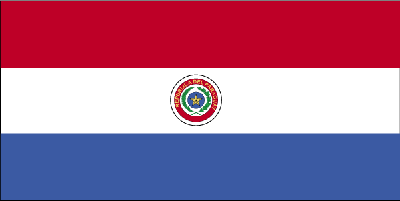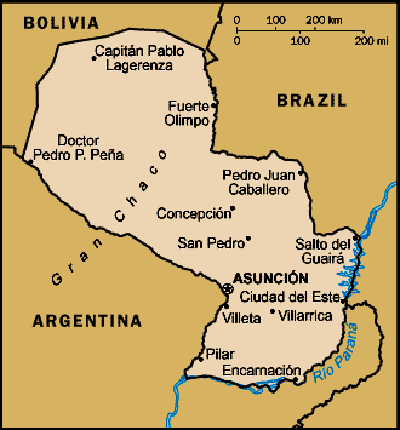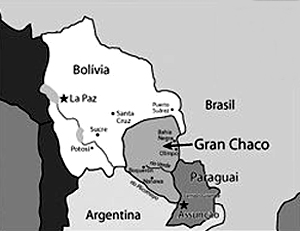PARAGUAY
|
Three horizontal bands of red, white, and
blue with an emblem in the center; the emblem is different on each side of
the flag; the front side has the national coat of arms (a yellow five-pointed
star within a green wreath capped by the words República del
Paraguay); the back side has the seal of the treasury (a yellow lion below a
red Cap of Liberty and the words Paz y Justicia (Peace and Justice) and the
words República del Paraguay also. |
|
NAME: República
del Paraguay (The name comes from Guaraní words for "water"
and "sea".)
POPULATION: 6,900,000
(2008); 6,700,000 (2014)
ETHNIC GROUPS: Mestizo (95%); Amerindian (4%); White (1%)
CAPITAL: Asunción,
2,000,000)
LANGUAGES: Official
languages: Spanish and Guaraní
RELIGION: Roman
Catholic (90%); Protestant (6%)
LIFE EXPECTANCY: Men (73); women (79)
LITERACY: 95%
GOVERNMENT: Democratic
constitutional republic
President: Fernando
Armindo Lugo Méndez (1951 – present)
Legislature: Bicameral
Congress
MILITARY: Army,
National Navy (Armada Nacional, Naval Aviation, Marine Corps), Air Force
(Fuerza Aérea Paraguaya, FAP)
ECONOMY: Exports:
bananas, shrimp, sugar, coffee, and clothing
MONEY: Guaraní
(PYG)
(5,000 PYG = $1.00 US)
GEOGRAPHY:
INTERNET
CODE: .py
HISTORY:
11,000
BCE (or
up to 34,000 BCE): pre-Colombian settlers
pre-1537 Seminomadic,
Guaraní-speaking tribes, who were reputed to be fierce warriors
1515 Juan
Díaz de Solís was the first Spanish explorer to set foot on
present-day
1537 Juan
de Salazar y Espinoza (Spanish explorer) founded the Spanish colonial city of
1593-1767 The
Jesuits control
1767 The
Jesuits were expelled from all Spanish territories all around the world.
1811 May
14: Independence Day from
1811-1816 The
actual fighting for independence in
1816-1840 Dictatorship
under José Gaspar Rodríguez de Francia. Francia
was one of the worst dictators in world history.
1840-1865 Dictatorships
under Carlos Antonio López and Francisco Solano López, two more
terrible dictators.
1865-1870 The
War of the Triple Alliance:
1870-1904 National
reconstruction controlled and led by governements under the Colorado Party,
which alternated and contended for power with the Liberal Party.
1904-1932 Government
controlled by various governments under the Liberal Party.
1932-1935 The
|
|
1947-1954 Civil
War in
1954-1989 Dictatorship
under Alfredo Stroessner.
1989-present Functioning
democracy in
1992 Current
Constitution promulgated
2003-2008 President Nicanor Duarte Frutos
2008-2013 Paraguay
elected Fernando
Armindo Lugo Méndez,
a former Catholic bishop, as president. His election victory broke 60
consecutive years of power for the Colorado Party.
2012 …,
but, in 2012 President Lugo Méndez was charged by the Senate with
“poor performance of his duties;” he was impeached, convicted, and
removed from office; he was replaced as president by the vice president, Federico
Franco, who will finish the term in 2013.
2013–2018 Horacion
Cartes electes president
PRINCIPAL
POLITICAL PARTIES:
Asociacion
Nacional Republicana (Colorado Party, ANR)
Movimiento
Union Nacional de Ciudadanos Eticos (UNACE);
Patria Querida (Beloved
Fatherland Party, PQ)
Partido Encuentro Nacional (PEN)
Partido
Liberal Radical Autentico (PLRA)
Partido
País Solidario (PPS)
CULTURE:
Synchretism
of European humanities with Amerindian culture, especially the Guaraní.
Augusto
Roa Bastos (1917-2005) was one of




